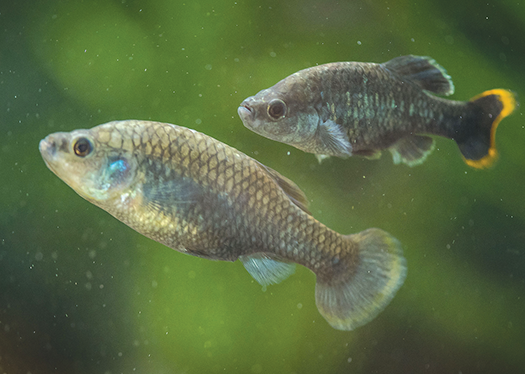
Tequila fish are making a comeback in the Teuchitlán River, thanks to years of work by scientists from the UK’s Chester Zoo and Mexico’s Michoacán University of San Nicolás de Hidalgo. (Photo courtesy of Chester Zoo)
Hailed as a landmark for conservation, the Tequila Splitfin (Zoogoneticus tequila), a fish considered extinct in the wild in 2003, is now flourishing in the Teuchitlán River of Mexico’s Jalisco state, thanks to a reintroduction effort of over seven years.
The small freshwater species disappeared from the Teuchitlán, its only natural habitat, nearly 20 years ago. The cause is not clearly understood, with explanations ranging from competition with exotic species to water pollution. But now the river’s Tequila Splitfin population has been restored, thanks to community waste-control efforts and the reintroduction work of conservationists from the Chester Zoo in England and Mexico’s Michoacán University of San Nicolás de Hidalgo (UMSNH).
The scientists reintroduced Tequila Splitfin in the Teuchitlán River at intervals, releasing 1,500 in all. Now, a wild population is “breeding naturally at a tremendous rate,” Gerardo García, curator of lower vertebrates and invertebrates at Chester Zoo, announced on Dec. 28.
The work grew out of a broader conservation project begun in 1998. That’s when zoologists from Chester Zoo and other European institutions teamed with Mexican scientists to create a laboratory devoted to endangered fish endemic to the Michoacán region, says Omar Domínguez, a UMSNH biologist and a leader of the effort. The aquatic biology laboratory they created, located on the UMSNH campus, was dubbed the “Fish Ark.”
Building a population
The original Tequila Splitfins were brought to the laboratory from the Chester Zoo in 2000 by British aquarist Ivan Dibble, one of the Fish Ark’s founders. Now, after a decade and a half, the lab’s artificial ponds host 10,000 Tequila Splitfins, which reach a maximum size of 70 millimeters (2.75 inches). After extensive groundwork, the actual reintroduction began in 2014. Observing the fish in their natural habitat since then, scientists have pronounced the reintroduction successful.
“It’s a nice story because the Tequila Splitfins that ended up being introduced in the wild are descendants of ones we sent to Domínguez right when we first started supporting their work,” says Paul Bamford of Chester Zoo. “The reintroduced fish are being monitored and the information shows that the population is still reproducing, still increasing and still healthy.”
The Tequila Splitfin is a member of the Goodeidae family of fish. This family includes some 45 unique species, almost all of which are endemic to central Mexico and some of which are extinct in the wild or threatened by pollution and predatory non-indigenous species. The UMSNH Fish Ark focuses mainly on preserving Goodeidae habitats, breeding, and preventing extinction of endangered fish species. It maintains populations of 41 Goodeidae species, which make up the large majority of the center’s fish species, as well as two types of endangered frogs.
Domínguez says potential funders initially viewed the reintroduction project as “impossible.” But with slim budgets, UMSNH scientists built a pond in the university’s botanical garden where conditions were comparable to those of the Teuchitlán River. After four years, the Tequila Splitfin population in the pond had grown to its current level of 10,000.
Research groundwork
The reintroduction was preceded by three research phases. The first was to understand the natural habitat of the Teuchitlán River: water conditions, pollution levels, types of fish species, predators, available food sources and the ecological and biological makeup of the ecosystem. The second was to study the Tequila Splitfin on site at UMSNH and learn how it reproduces and behaves. The third phase, Domínguez says, was to pinpoint the location on the Teuchitlán that would be most conducive to reintroduction.
“We conducted pre-release experiments where we kept the species in floating cages in the river and studied the trophic ecology, reproduction processes and interactions with other species, among other trials,” Domínguez says. “Once reintroduced, the species was observed for a period of five years to monitor its adaptation, reproduction, dietary and social habits.”
Domínguez says the Tequila Splitfin has been observed some 1,500 meters from its reintroduction location, an indication it has adapted and migrated. UMSNH and Chester Zoo scientists are now carrying out the “soft release” of another Goodeidae species, the Golden Skiffa (Skiffia francesae), into the Teuchitlán. They also reintroduced the Ameca shiner (Notropis amecae) into the Teuchitlán at the same time as the Tequila Splitfin, though Banford reports that these fish have not shown the same kind of “successful generational turnover.”
Says Domínguez: “The principal purpose of the Fish Ark is to maintain threatened species from central Mexico and keep them from going extinct, and, if possible, reintroduce them to their natural habitat, as we did with the Tequila Splitfin. This is the first time a fish species declared extinct in the wild has been successfully reintroduced to its habitat in Mexico and, as we understand, all of Latin America.”
- Adam Williams